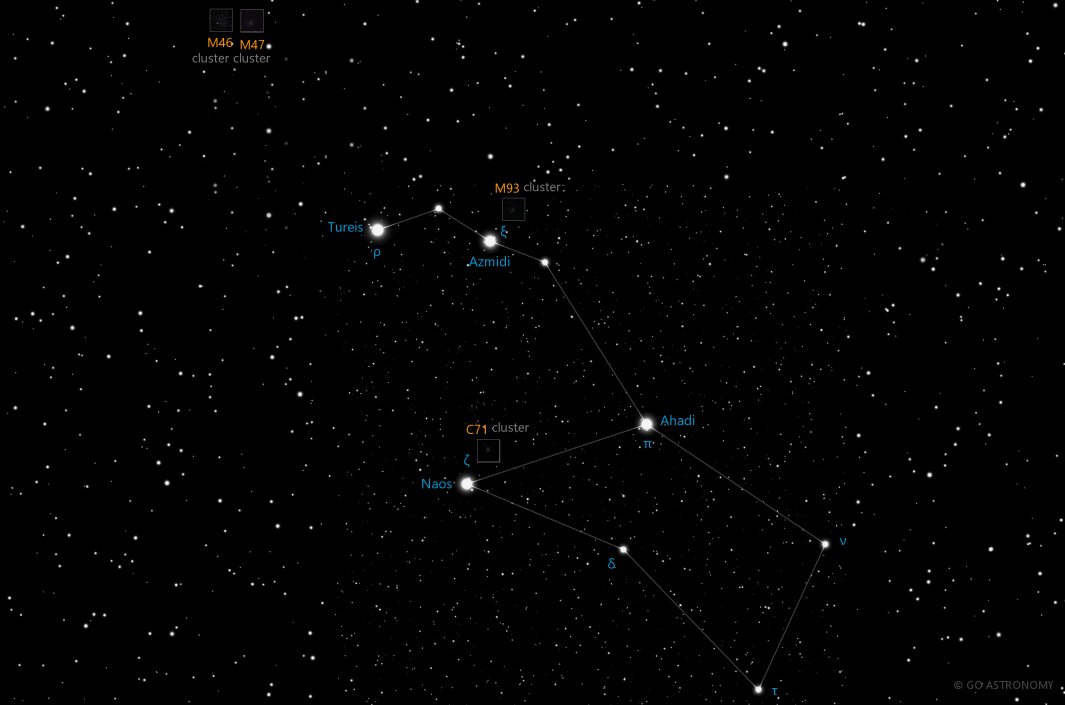Puppis, the Stern (Pup)
(PUP-iss)
The Southern constellation of Puppis, the Stern, is best viewed in Spring during the month of March.
Puppis is the 20th largest constellation. It's brightest star is Naos at magnitude 2.25. The boundary of the Puppis constellation contains 10 stars that host known exoplanets.
- Pronunciation:
- PUP-iss
- Meaning:
- Stern
- Genitive:
- Puppis
- Abbreviation:
- Pup
- Constellation Family:
- Heavenly Waters
- Hemisphere:
- Southern
- Quadrant:
- SQ2
- Visibility:
- 40° N - 90° S
- Best viewing month*:
- March
- Area:
- 673 sq. degrees
- Size:
- 20th largest
- Right Ascension (avg):
- 7h 52m
- Declination (avg):
- -34°
- Brightest star:
- Naos (2.25)
- Stars with planets:
- 10
Brightest Stars in Puppis
The 10 brightest stars in the constellation Puppis by magnitude.
- Star
- Magnitude
- Spectral class
- Zeta Puppis (ζ Pup)
- 2.21
- O5Iaf
- Pi Puppis (π Pup)
- 2.71
- K3Ib
- Rho Puppis (ρ Pup)
- 2.83
- F2mF5IIp
- Tau Puppis (τ Pup)
- 2.94
- K0III
- Nu Puppis (ν Pup)
- 3.17
- B8III SB
- Sigma Puppis (σ Pup)
- 3.25
- K5III SB
- Xi Puppis (ξ Pup)
- 3.34
- G6Ia
- c Puppis (c Pup)
- 3.62
- K4III
- HD 64440
- 3.71
- G5III
- 3 Puppis (3 Pup)
- 3.94
- A2Iab
Double Stars in Puppis
These are the brightest and easiest-to-find double, triple, and quadruple star systems in the constellation Puppis. Also see all star clusters.
- Star system
- Magnitudes
- Type
- k Puppis
- 4.4, 4.6
- double
Star Clusters in Puppis
The most notable and easy-to-find star clusters in the constellation Puppis . Also see all star clusters.
- Star cluster
- Catalog #
- Cluster type
- Messier 46
- M46
- open
- Messier 47
- M47
- open
- Messier 93
- M93
- open
- NGC 2298
- globular
- NGC 2439
- open
- NGC 2451
- open
- NGC 2509
- open
Nebulae in Puppis
Notable and easy-to-find nebulae in the constellation Puppis. Also see all nebulae.
- Nebula name
- Catalog #
- Nebula type
- Calabash Nebula
- protoplanetary
- Puppis A
- supernova remnant
- Bow Nebula
- planetary
- Skull & Crossbones Nebula
- H II region
Neutron Stars in Puppis
These are the most well-known neutron stars in the constellation Puppis. Although neutron stars cannot be seen in any amateur telescope, they are at the center of many supernova remnant nebulae, which can be seen. Also see all neutron stars.
The Stern of the Celestial Ship
The constellation Puppis is a fascinating feature of the Southern celestial hemisphere. Known as the "Stern of the Ship," Puppis was once part of a much larger constellation, Argo Navis.
Historical Background
Puppis was not recognized as a separate constellation until the 18th century, when French astronomer Nicolas Louis de Lacaille divided the massive constellation Argo Navis into three more manageable segments - Carina (The Keel), Vela (The Sails), and Puppis (The Stern). Argo Navis represented the ship used by Jason and the Argonauts in Greek mythology. Despite the division, the three segments are still collectively referred to as the Argo.
Location and Visibility
Puppis is situated in the second quadrant of the Southern hemisphere (SQ2) and can be observed between latitudes +40? and -90?. It is the 20th largest constellation, occupying an area of 673 square degrees. Puppis is surrounded by several constellations, including Pyxis, Vela, Carina, Pictor, Columba, Canis Major, Monoceros, and Hydra. Puppis is best visible in the evening sky in the months of February and March.
Main Stars in Puppis
Despite being a relatively large constellation, Puppis lacks bright stars. Its brightest star, Zeta Puppis (also known as Naos), is a blue supergiant and one of the most luminous stars known in our galaxy. Other main stars in Puppis include Rho Puppis, a yellow-white giant with notable brightness variations, and Pi Puppis, a binary star system with an orange giant primary.
Deep Sky Objects
Due to its location away from the plane of the Milky Way, Puppis hosts a rich array of deep-sky objects. Notably, it is home to the open clusters M46 and M47, both of which were cataloged by Charles Messier. M46 is a dense cluster with hundreds of stars and includes a planetary nebula within its boundary. M47, in contrast, is a looser cluster, but its stars are brighter and easily visible through small telescopes. Another remarkable deep-sky object within Puppis is NGC 2451, a star cluster that features c Puppis, a yellow supergiant star.
Observation
Observing Puppis can be an interesting challenge for stargazers in the Northern hemisphere because the constellation remains low on the horizon and is best seen from Southern latitudes. However, its brightest star, Zeta Puppis, can still be seen from most Northern locations. The constellation's deep-sky objects, such as M46 and M47, are accessible through small telescopes and are rewarding targets for amateur astronomers.
Conclusion
With its rich array of deep-sky objects and its unique history as part of the former Argo Navis constellation, Puppis is a constellation of considerable interest. Its visibility from southern latitudes and the variety of its stellar objects make it an appealing subject for both professional astronomers and amateur stargazers. Whether you're exploring the deep-sky objects within its boundaries or tracing the outlines of the ancient ship, Puppis offers a fascinating exploration of the universe's stern.
* Constellation shown for northen hemisphere skies. For the southern hemisphere, constellations appear rotated 180 degrees (upside-down and left-right reversed) from what is shown. Remember that seasons are reversed too - summer in northern latitudes is winter in southern latitudes.
** Circumpolar constellations are visible year-round in the hemisphere listed (and not at all in the opposite hemisphere).





